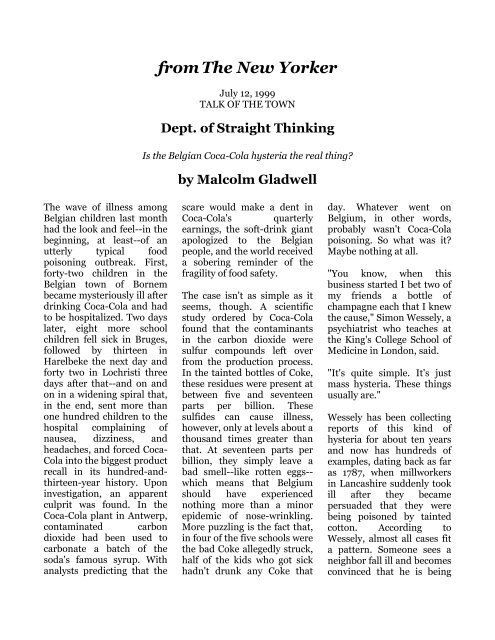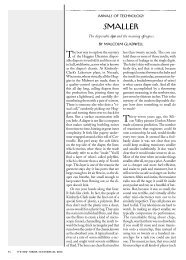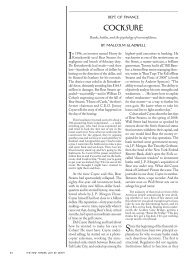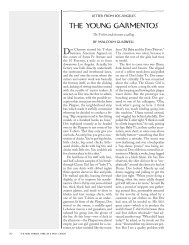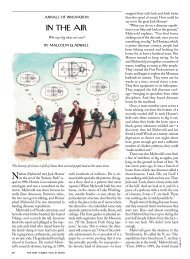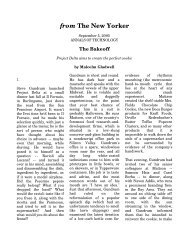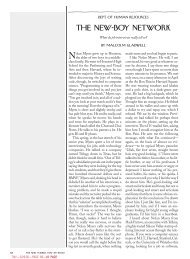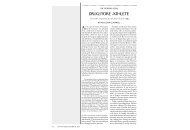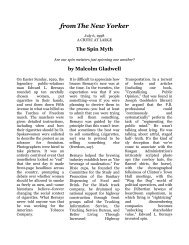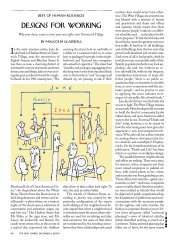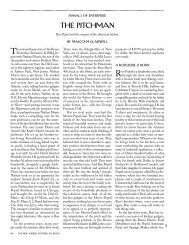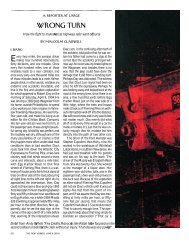fromThe New Yorker - Malcolm Gladwell
fromThe New Yorker - Malcolm Gladwell
fromThe New Yorker - Malcolm Gladwell
Create successful ePaper yourself
Turn your PDF publications into a flip-book with our unique Google optimized e-Paper software.
The wave of illness among<br />
Belgian children last month<br />
had the look and feel--in the<br />
beginning, at least--of an<br />
utterly typical food<br />
poisoning outbreak. First,<br />
forty-two children in the<br />
Belgian town of Bornem<br />
became mysteriously ill after<br />
drinking Coca-Cola and had<br />
to be hospitalized. Two days<br />
later, eight more school<br />
children fell sick in Bruges,<br />
followed by thirteen in<br />
Harelbeke the next day and<br />
forty two in Lochristi three<br />
days after that--and on and<br />
on in a widening spiral that,<br />
in the end, sent more than<br />
one hundred children to the<br />
hospital complaining of<br />
nausea, dizziness, and<br />
headaches, and forced Coca-<br />
Cola into the biggest product<br />
recall in its hundred-andthirteen-year<br />
history. Upon<br />
investigation, an apparent<br />
culprit was found. In the<br />
Coca-Cola plant in Antwerp,<br />
contaminated carbon<br />
dioxide had been used to<br />
carbonate a batch of the<br />
soda's famous syrup. With<br />
analysts predicting that the<br />
from The <strong>New</strong> <strong>Yorker</strong><br />
July 12, 1999<br />
TALK OF THE TOWN<br />
Dept. of Straight Thinking<br />
Is the Belgian Coca-Cola hysteria the real thing?<br />
by <strong>Malcolm</strong> <strong>Gladwell</strong><br />
scare would make a dent in<br />
Coca-Cola's quarterly<br />
earnings, the soft-drink giant<br />
apologized to the Belgian<br />
people, and the world received<br />
a sobering reminder of the<br />
fragility of food safety.<br />
The case isn't as simple as it<br />
seems, though. A scientific<br />
study ordered by Coca-Cola<br />
found that the contaminants<br />
in the carbon dioxide were<br />
sulfur compounds left over<br />
from the production process.<br />
In the tainted bottles of Coke,<br />
these residues were present at<br />
between five and seventeen<br />
parts per billion. These<br />
sulfides can cause illness,<br />
however, only at levels about a<br />
thousand times greater than<br />
that. At seventeen parts per<br />
billion, they simply leave a<br />
bad smell--like rotten eggs-which<br />
means that Belgium<br />
should have experienced<br />
nothing more than a minor<br />
epidemic of nose-wrinkling.<br />
More puzzling is the fact that,<br />
in four of the five schools were<br />
the bad Coke allegedly struck,<br />
half of the kids who got sick<br />
hadn't drunk any Coke that<br />
day. Whatever went on<br />
Belgium, in other words,<br />
probably wasn't Coca-Cola<br />
poisoning. So what was it?<br />
Maybe nothing at all.<br />
"You know, when this<br />
business started I bet two of<br />
my friends a bottle of<br />
champagne each that I knew<br />
the cause," Simon Wessely, a<br />
psychiatrist who teaches at<br />
the King's College School of<br />
Medicine in London, said.<br />
"It's quite simple. It's just<br />
mass hysteria. These things<br />
usually are."<br />
Wessely has been collecting<br />
reports of this kind of<br />
hysteria for about ten years<br />
and now has hundreds of<br />
examples, dating back as far<br />
as 1787, when millworkers<br />
in Lancashire suddenly took<br />
ill after they became<br />
persuaded that they were<br />
being poisoned by tainted<br />
cotton. According to<br />
Wessely, almost all cases fit<br />
a pattern. Someone sees a<br />
neighbor fall ill and becomes<br />
convinced that he is being
contaminated by some<br />
unseen evil--in the past it<br />
was demons and spirits;<br />
nowadays it tends to be<br />
toxins and gases--and his<br />
fear makes him anxious. His<br />
anxiety makes him dizzy and<br />
nauseous. He begins to<br />
hyperventilate. He collapses.<br />
Other people hear the same<br />
allegation, see the "victim"<br />
faint, and they begin to get<br />
anxious themselves. They<br />
feel nauseous. They<br />
hyperventilate. They<br />
collapse, and before you<br />
know it everyone in the<br />
room is hyperventilating<br />
and collapsing. These<br />
symptoms, Wessely stresses,<br />
are perfectly genuine. It's<br />
just that they are<br />
manifestations of a threat<br />
that is wholly imagined.<br />
"This kind of thing is<br />
extremely common," he<br />
says, "and it's almost<br />
normal. It doesn't mean that<br />
you are mentally ill or<br />
crazy."<br />
Mass hysteria comes in<br />
several forms. Mass motor<br />
hysteria, for example,<br />
involves specific physical<br />
movements: shaking,<br />
tremors, and convulsions.<br />
According to the sociologist<br />
Robert Bartholomew, motor<br />
hysteria often occurs in<br />
environments of strict<br />
emotional repression; it was<br />
common in medieval<br />
nunneries and in<br />
nineteenth-century<br />
European schools, and it is<br />
seen today in some Islamic<br />
cultures. What happened in<br />
Belgium, he says, is a fairly<br />
typical example of a more<br />
standard form of contagious<br />
anxiety, possibly heightened<br />
by the recent Belgian scare<br />
over dioxin-contaminated<br />
animal feed. The students'<br />
alarm over the rotten-egg<br />
odor of their Cokes, for<br />
example, is straight out of the<br />
hysteria textbooks. "The vast<br />
majority of these events are<br />
triggered by some abnormal<br />
but benign smell," Wessely<br />
said. "Something strange, like<br />
a weird odor coming from the<br />
air conditioning."<br />
The fact that the outbreaks<br />
occurred in schools is also<br />
typical of hysteria cases. "The<br />
classic ones always involve<br />
schoolchildren," Wessely<br />
continued. "There is a famous<br />
British case involving<br />
hundreds of schoolgirls who<br />
collapsed during a 1980<br />
Nottinghamshire jazz festival.<br />
They blamed it on a local<br />
farmer spraying pesticides."<br />
Bartholomew has just<br />
published a paper on a<br />
hundred and fifteen<br />
documented hysteria cases in<br />
schools over the past three<br />
hundred years. As anyone<br />
who has ever been to a rock<br />
concert knows, large numbers<br />
of adolescents in confined<br />
spaces seem to be particularly<br />
susceptible to mass hysteria.<br />
Those intent on pointing the<br />
finger at Coca-Cola in this<br />
sorry business ought to<br />
remember that. "We let the<br />
people of Belgium down,"<br />
Douglas Ivester, the<br />
company's chairman, said in<br />
the midst of the crisis. Or<br />
perhaps it was the other way<br />
around.<br />
© 1999 <strong>Malcolm</strong> <strong>Gladwell</strong>


